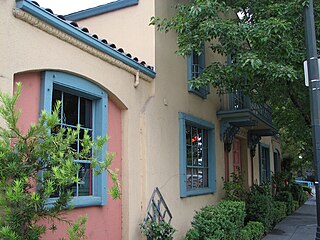
Sonoma County is a county in the U.S. state of California. As of the 2010 United States Census, its population was 483,878. Its county seat and largest city is Santa Rosa. It is to the north of Marin County and the south of Mendocino County. It is west of Napa County and Lake County.

Santa Rosa is a city and the county seat of Sonoma County, in the North Bay region of the Bay Area in California. Its estimated 2019 population was 176,753. Santa Rosa is the largest city in California's Wine Country and Redwood Coast, as well as the fifth most populous city in the Bay Area after San Jose, San Francisco, Oakland, and Fremont; and the 27th most populous city in California.

The BNSF Railway Company is the largest freight railroad network in North America. One of seven North American Class I railroads, BNSF has 41,000 employees, 32,500 miles (52,300 km) of track in 28 states, and more than 8,000 locomotives. It has three transcontinental routes that provide rail connections between the western and eastern United States. BNSF trains traveled over 169 million miles in 2010, more than any other North American railroad.
The Golden Gate Railroad Museum is a non-profit railroad museum in California that is dedicated to the preservation of steam and passenger railroad equipment, as well as the interpretation of local railroad history.

The establishment of America's transcontinental rail lines securely linked California to the rest of the country, and the far-reaching transportation systems that grew out of them during the century that followed contributed to the state's social, political, and economic development. When California was admitted as a state to the United States in 1850, and for nearly two decades thereafter, it was in many ways isolated, an outpost on the Pacific, until the First Transcontinental Railroad was completed in 1869.

The California Northern Railroad is one of several Class III short-line railroad companies owned by Genesee & Wyoming, Inc. It operates over Southern Pacific Railroad (SP) tracks under a long-term lease.

The Northwestern Pacific Railroad is a railroad covering the 62 mi (100 km) stretch between Schellville and Windsor with freight and Sonoma–Marin Area Rail Transit (SMART) commuter trains. Formerly, it was a regional railroad that served the entire North Coast of California, with a main line running 271 miles (436 km) from Schellville to Eureka, along with an additional portion of the line running from the Ignacio Wye to the edge of San Rafael. The portion of the NWP main line between the Ignacio Wye in Marin County and the depot in Healdsburg is owned by SMART. The Schellville–Ignacio and Healdsburg–Eureka portions are owned by the North Coast Railroad Authority (NCRA). Private contractor NWPco operates freight service under NCRA lease. California's 2018 Great Redwood Trail Act repurposes the abandoned railroad right-of-way from Eureka to the San Francisco Bay in Marin County for future use as the "Great Redwood Trail" rail-trail.

The Sacramento Northern Railway was a 183-mile (295 km) electric interurban railway that connected Chico in northern California with Oakland via the California capital, Sacramento. In its operation it ran directly on the streets of Oakland, Sacramento, Yuba City, Chico, and Woodland and ran interurban passenger service until 1941 and freight service into the 1960s.

The Santa Clara Depot is one of two heavy railway stations in Santa Clara, California. It is served by Caltrain from San Francisco, and is also served by the Altamont Corridor Express (ACE) from Stockton. This station is the planned terminal for the Silicon Valley BART extension into Santa Clara County and will be preceded by Diridon/Arena BART station with direct service to San Francisco/Daly City and Richmond.

The North Pacific Coast Railroad (NPC) was a common carrier 3 ft narrow-gauge steam railroad begun in 1874 and sold in 1902 to new owners who renamed it the North Shore Railroad (California) (NSR) and which rebuilt the southern section into a standard-gauge electric railway.

San Francisco Bay in California has been served by ferries of all types for over 150 years. John Reed established a sailboat ferry service in 1826. Although the construction of the Golden Gate Bridge and the San Francisco–Oakland Bay Bridge led to the decline in the importance of most ferries, some are still in use today for both commuters and tourists.

The South Pacific Coast Railroad (SPC) was a 3 ft narrow gauge steam railroad running between Santa Cruz, California and Alameda, with a ferry connection in Alameda to San Francisco. The railroad was created as the Santa Clara Valley Railroad, founded by local strawberry growers as a way to get their crops to market in San Francisco and provide an alternative to the Southern Pacific Railroad. In 1876, James Graham Fair, a Comstock Lode silver baron, bought the line and extended it into the Santa Cruz Mountains to capture the significant lumber traffic coming out of the redwood forests. The narrow-gauge line was originally laid with 52-pound-per-yard (26 kg/m) rail on 8-foot (2.44 m) redwood ties; and was later acquired by the Southern Pacific and converted to 4 ft 8 1⁄2 instandard gauge.

Petaluma and Santa Rosa Railroad was a 600 volt DC electric interurban railway in Sonoma County, California, United States. It operated between the cities of Petaluma, Sebastopol, Forestville, and Santa Rosa. Company-owned steamboats provided service between Petaluma and San Francisco.

Martinez station is an Amtrak passenger train station in Martinez, California, United States. Located at the west end of downtown Martinez, the station has one side platform and one island platform, which serve three of the four tracks of the Union Pacific Railroad Martinez Subdivision. It is served by the daily California Zephyr and Coast Starlight long-distance trains, five daily round trips of the San Joaquin corridor service, and fifteen daily round trips of the Capitol Corridor service. Martinez is also served by Amtrak Thruway Motorcoach intercity buses plus County Connection, WestCAT, and Tri-Delta Transit local buses.
Rail transportation is an important element of the transportation network in the U.S. state of Oregon. Rail transportation has existed in Oregon in some form since 1855, and the state was a pioneer in development of electric railway systems. While the automobile has displaced many uses of rail in the state, rail remains a key means of moving passengers and freight, both within the state and to points beyond its borders.

San Francisco and North Pacific Railroad (SF&NP) provided the first extensive standard gauge rail service to Sonoma County and became the southern end of the regional Northwestern Pacific Railroad. Although first conceived of by Asbury Harpending, who had even obtained many of the right of ways, the SF & NP was bought and subsequently constructed by Peter Donahue, who drove the first spike on August 30, 1869.
San Francisco and Northwestern Railway (SF&NW) was an Atchison, Topeka and Santa Fe Railway subsidiary formed in 1903 to connect Humboldt Bay to the Santa Fe rail system.
This article lists the railroads and a timeline of railroad history in Solano County, California.

Schellville is an unincorporated community in Sonoma County, California, United States. Schellville is located in the vicinity of the junction of California State Route 12 and California State Route 121 south of Sonoma. The community had a post office from 1888 to 1931.















